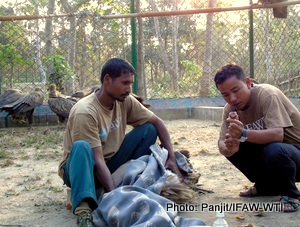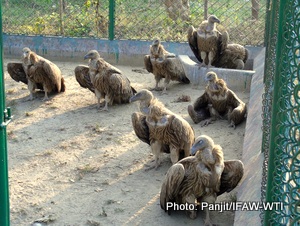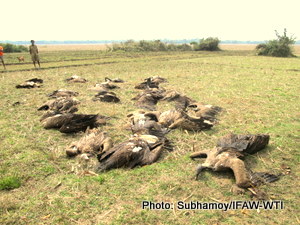Vultures in Assam Continue to Succumb to Poisoning
CWRC, March 11, 2015: On March 7, the IFAW-WTI run CWRC was informed about the poisoning of vultures in Knowerpur village of Sivasagar district in Assam. The team of CWRC vets rushed to the spot and found nine vultures in a comatose state. On further enquiry, the Forest Department revealed that 20 vultures succumbed to poisoning and had already been buried. They also revealed that the vultures were feeding on a dog carcass which had been poisoned by the locals. The surviving nine vultures were taken to CWRC and unfortunately one of them died on its way to CWRC. Overall, a total of 21 vultures succumbed and only eight could be saved which are now recuperating at the CWRC in Assam.
Shockingly, more than 134 vultures (including 102 himalayan griffon and 12 critically endangered slender-billed and 20 white-rumped) have succumbed to poisoning this year alone and only 20 have been rescued while two have been successfully released by the CWRC team. In March alone, 77 vultures died of poisoning which came as a setback to conservationists in the country. In January 2015, the conservation lobby was traumatized after the news of death of 50 vultures was reported from Tengapani village in Sivasagar. On February 17, IFAW-WTI run CWRC released one vulture rescued from Tengapani village.
Despite drastic decline in vulture populations (slender billed and white rumped) in the 1990s that edged them menacingly towards extinction, vultures continue to fall victim to human apathy even today. Although efforts are being made by governments as well as non-government institutions to curb this downfall, reckless activities by people residing within home range of vultures, continue to take a toll on this dying group of scavengers, across India.
“The practice of poisoning birds and mammals is commonly reported from Assam and though it had been on a decline in the last few years, this year it seems to have revived again. Since this is largely agriculturally dominant landscape there is no dearth of pesticides which are used to poison carcasses. It is disheartening to see that despite the state having the largest network of NGOs working for conservation, there has been little or no change in people’s perception about the consequences of poisoning,” said Dr NVK Ashraf, Chief Veterinarian, WTI.
Population of three Gyps vultures decreased by about 95% within as few as three years in the 1990s, across parts of their home range in south Asia (Source: Birdlife International). Once commonly-used livestock analgesic/anti-inflammatory drug ‘Diclofenac’ was identified as one of the main causes. Use of ‘Diclofenac’ is presently banned in India. However, threats like secondary poisoning continue to haunt vulture populations across the country, especially Assam.
It is to be noted that most of these deaths are cases of secondary poisoning wherein vultures were not the target of the locals. Therefore, it becomes pertinent that awareness programmes are organised for locals to make them understand the consequences of such stray poisoning incidents which prove to be fatal for vultures.












